

The Evolution of Leadership Training - HR Daily Advisor. The leadership development and coaching industries are undergoing a major transformation due to the dramatic shifts in remote workforce policies in response to COVID-19.
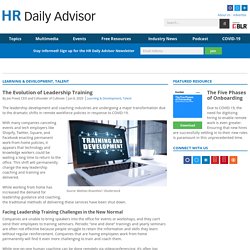
Source: Mathias Rosenthal / Shutterstock With many companies canceling events and tech employers like Shopify, Twitter, Square, and Facebook enacting permanent work-from-home policies, it appears that technology and knowledge workers could be waiting a long time to return to the office. Will COVID-19 drastically impact talent management? This sentiment will “undoubtedly endure” in the post-pandemic world, so HR leaders need to showcase their commitment to providing stability and growth opportunities to employees.

“Pay and rewards should not be viewed in a silo but as part of the overall employee experience,” she said. “It should also give consideration to responsible rewards, protecting employees’ well-being, and having a sense of purpose that ties in environmental and social concerns.” READ MORE: COVID-19: A 'wake-up call' to rethink business priorities To prepare employees for the ‘new normal’, she added that leaders must invest in reskilling, upskilling and offering continuous learning opportunities to employees. This will ensure that employees will successfully adapt to wider adoptions of digital transformation and automation in the future of work. New Leadership Challenges for the Virtual World of Work.
The COVID-19 pandemic has suddenly and dramatically upended the working world, creating unanticipated business and leadership challenges.

Some organizations are pivoting hard to new delivery channels, new products, and new operating models without having enough time to manage the impact of these changes thoughtfully. As a result, many executives currently find themselves shooting from the hip, bereft of their usual channels to engage deeply with stakeholders and gain agreement on the path forward. The rapid shift to remote work has brought on other challenges for organizations. Effective performance measurement, management, and accountability are always a challenge. In this suddenly almost exclusively virtual world, where it’s much easier for employees to become almost invisible, how can we recognize and reward great performance and also deal with performance challenges? Email updates on the Future of Work Please enter a valid email address Thank you for signing up Privacy Policy.
5 Questions That (Newly) Virtual Leaders Should Ask Themselves. While technology has improved our ability to get work done and communicate remotely, we have not yet been forced to develop a set of best practices for leading remote teams at the capacity that has been brought on by this crisis.
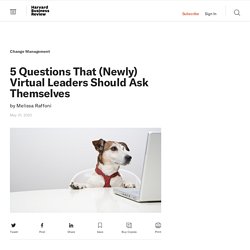
8 leadership skills to lead through uncertainty. Disruptive change creates uncertainty and we resist it because it is uncomfortable.

Uncertainty generates a range of emotions, polarises opinions and can lead to relationships breaking down. It requires great skill and flexibility to lead through uncertainty. It is also an opportunity for leaders and teams to do meaningful work that makes a difference. As part of my research into uncertainty, I held a round table discussion with a group of thought leaders from different backgrounds and sectors to identify the skills needed to lead through uncertainty. I tested the findings by interviewing CEOs and senior leaders on their experiences, as well as drawing on my own experiences.
5 Musts for Next-Gen Leaders. Topics Frontiers An MIT SMR initiative exploring how technology is reshaping the practice of management.
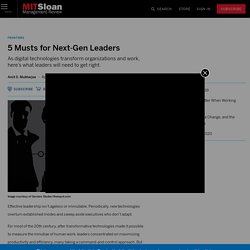
See All Articles in This Section. Leadership in the New Now. The Head As uncertainty reigns supreme, the responsibility of leaders to craft vivid visions of the future and to lay out a clear path to success becomes more important than ever.
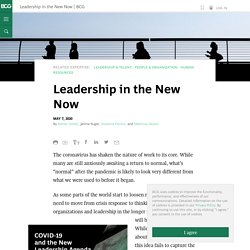
Microsoft excels at creating an aspirational vision that helps guide everything from the company’s overarching strategy down to individual employees’ actions and motivation. In an email to employees in March, when the full scope of this crisis was starting to become clear, CEO Satya Nadella wrote to employees to share his vision, explaining that “during this extraordinary time, it is clear that software, as the most malleable tool ever created, has a huge role to play across every industry and around the world.” The vision Nadella laid out is at once steadfast and flexible. We Need Imagination Now More Than Ever. The idea of “crisis management” requires no explanation right now.
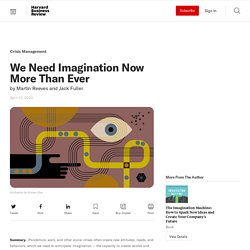
Something unexpected and significant happens, and our first instincts are to defend against — and later to understand and manage — the disturbance to the status quo. The crisis is an unpredictable enemy to be tamed for the purpose of restoring normality. A leader's guide to crisis communication during coronavirus.
This article is part of a series Leadership in a crisis: Responding to the coronavirus outbreak and future challenges.

It draws together McKinsey’s collective thinking and expertise on five behaviors to help leaders navigate the pandemic and recovery. Separate articles describe organizing via a network of teams; displaying deliberate calm and bounded optimism; making decisions amid uncertainty; and demonstrating empathy. Leaders, Do You Have a Clear Vision for the Post-Crisis Future? Executive Summary As the Covid-19 pandemic shakes the global economy and disrupts the way we live, work, and conduct business, leaders are scrambling to manage the immediate fallout.
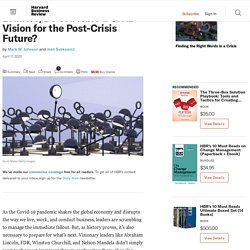
But, as history proves, it’s also necessary to prepare for what’s next. The authors suggest (1) dedicating about 10 to 20 percent of your time on a weekly basis over the next few months to exploring and envisioning where you want your organization to be when the crisis passes; (2) laying out a path from your long-term aspiration to the mid-term (your post-crisis focal point), and from there to today, while reverse-engineering a series of benchmarks and milestones at regular intervals along the way; (3) pivoting and learning along the way; and (4) rallying your team around your vision.
As the Covid-19 pandemic shakes the global economy and disrupts the way we live, work, and conduct business, leaders are scrambling to manage the immediate fallout. Navigating the Corporate Training Market During the COVID-19 Pandemic. We are experiencing unprecedented change due to the COVID-19 pandemic. The economic impact from this global health crisis remains to be seen, but it’s clear that the buying behaviors of corporate L&D functions have shifted dramatically in the past few weeks.
On TrainingIndustry.com, we’ve seen changes in the content and solutions attracting the most attention from our audience, which provides a glimpse into the challenges training professionals are currently experiencing — and how we can connect them with the resources they need to minimize business disruption during this turbulent time. This article will share our observations on the information and solutions that training professionals are currently seeking and research-based recommendations on how training companies can meet their needs.
Searching for Solutions We’ve seen an elevated interest in virtual training through an increase in registrations and attendance for our webinars, virtual conferences and podcasts. Moving Forward. Resilient leadership responding to COVID-19. Five fundamental qualities of resilient leadership distinguish successful CEOs as they guide their enterprises through the COVID-19 crisis. Learn specific steps that can help blunt the crisis’s impact—and enable your organization to emerge stronger. Leadership in the crucible of crisis The rapid global spread of COVID-19 has quickly eclipsed other recent epidemics in both size and scope.1 In addition to the deadly human toll and the disruption to millions of people’s lives, the economic damage is already significant and far-reaching. In the face of certain challenges and a still-uncertain set of risks, business leaders are rightly concerned about how their companies will be affected and what they have to do next.
In the heat of the moment, there are a number of lessons from history that can be applied now. How Learning Leaders Can Help Businesses Adapt During a Pandemic. The U.S. unemployment rate is skyrocketing. The stock market is uncertain at best. The restaurant industry has lost over 3 million jobs and $25 billion in sales as of March 1. The gig economy is at a standstill. Numerous employees have had to quickly figure out how to work from home, many while balancing child care and/or other caretaking responsibilities. As the coronavirus pandemic continues to disrupt daily life across the globe, businesses across industries are struggling to keep up. Change Management: It’s a Learning Process In today’s dynamic business environment, effective change management gives organizations a competitive edge.
Nicole Alvino, chief strategy officer at SocialChorus, echoes this sentiment, sharing, “As organizations are being forced to go remote and adapt to new ways of working, the need for flexibility has never been more acute. L&D can also help organizations remain agile during the pandemic. Change management is a learning process. Leading through a crisis: Applying the past to coronavirus. Savvy managers understand the fundamentals of crisis management, at least on the theoretical level. Their careers rise and fall on an individual’s ability to rally their teams, project deliberate calm and empathy, take decisive action, and communicate effectively. The most fortunate among them have not had to face a crisis like the coronavirus pandemic now rampaging through the global community to devastating effect. But there are managers out there whose stories and experiences of leadership in moments of disruption and upheaval can be instructive.
How leaders can maximize trust and minimize stress during the COVID-19 pandemic. People look to leaders for guidance on what to do, what to expect and how to act. During uncertain and fluid times, the need for strong, calm, trustworthy leadership is more important than ever. Psychologists’ research points to several ways that leaders — whether they are government officials, business managers, educators or parents — can improve their communication skills to maximize trust and minimize stress and anxiety: Manage stress. L&D Professionals Can Lead Through the Pandemic - Harvard Business Publishing.
Here Are The Top Five Leadership Challenges During The Coronavirus Pandemic. What Good Leadership Looks Like During This Pandemic. 4 Actions to Be a Good Leader During COVID-19 Disruption. Where executives focus during times of disruption and upheaval will define them as leaders. COVID-19 is causing a humanitarian crisis of global proportions, with hundreds of thousands of lives disrupted. Sadly, we’re not nearing the end of the crisis. In my day-to-day, I work with executive leaders and their teams on preparing for enterprise transformation. It’s no surprise that I’ve been musing for a while on what makes a great leader. In recent days, I’ve observed how COVID-19 is a test case for good and bad leadership.
Leaders at any level can take four specific actions. Build Resilience Through Recovery. Why Leadership Diversity Matters in Handling Crises Like COVID-19 - Knowledge@Wharton. Employee health and safety must be the foremost consideration of any business during the coronavirus pandemic. But one of the greatest challenges is understanding the needs and circumstances of employees who themselves are diverse in all of the traditional measures, but also are affected by widely varying life, work and family conditions, writes Lloyd W. Howell, Jr., in this opinion piece. Ten ways tech leaders can help guide the way during COVID-19. By Steve Bates, Principal, Global Leader, KPMG’s CIO Center of Excellence The COVID-19 pandemic is reshaping the world as we know it, presenting unique challenges that many business leaders have never confronted before.
With a continuously shifting landscape, IT resilience is key to protecting the health of both your people and your business. In the coming weeks and months, technology leaders managing through the crisis will follow three waves: stabilization of the core, optimization of estate, and emergence into a more competitive position. By taking action now in 10 priority areas, technology leaders can help their organizations respond to immediate operational, customer, employee, and financial disruptions, maintain business continuity as new challenges emerge, and realize a quick and competitive recovery after the crisis.
Focus on critical problems Don’t panic. Put people first This is a decidedly human crisis. Communicate Don’t let perfect be the enemy of good. HBR Leaders do you have a Clear Vision for the Post Crisis Future. Why CEOs Should Model Vulnerability. COVID-19 May Be The Best Thing That Ever Happened To Employee Engagement.